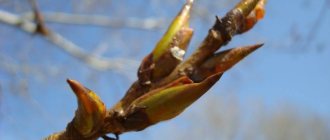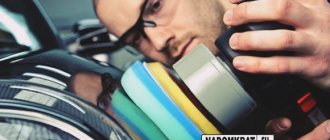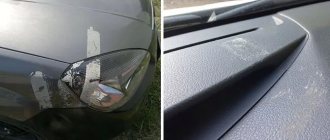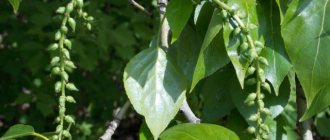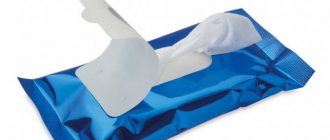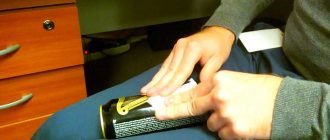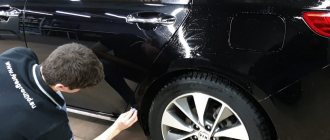Home » Stains of natural origin
Natural stains
Author Masha Klimova Reading time 6 min. Views 52.5k. Published 12/07/2016 Updated 05/04/2021
With the onset of spring, many car owners are faced with such a nuisance as the appearance of sticky poplar buds on the windshield, hood, and roof of the car. Removing sticky tree buds without damaging your car's paintwork is not an easy task.
Poplar buds contain a caustic resin that can penetrate the deepest layers of paint and, if not removed from the body in a timely manner, can turn into a hard dark speck. If this happens, it will be extremely difficult to cope with this type of pollution. Therefore, poplar or linden buds must be eliminated immediately, without waiting for them to penetrate into the paintwork.
Do not go straight to the car wash to remove these stains. As a rule, no one will bother with them at a car wash, especially since they do not always have both a cleaning agent and a gentle agent that does not leave scratches on the surface of the paintwork. Very often, after a car wash, small scratches remain on the car, which can only be removed by deep polishing. But even when cleaning the body yourself, not all products can be used so as not to cause damage to the paintwork.
It is best to protect your car from the appearance of this type of stain, namely:
- If possible, do not park under trees such as poplar or linden
- buy a protective cover for your car
- or with the onset of spring, cover the surface of the body with a specialized polish that has a prolonged effect. This layer of polish will create a thin layer of film that will have a protective effect for several months.
But if such a nuisance does happen, then it is necessary to think about all possible ways to remove traces of poplar buds from the car body, without causing damage to the timber plant.
Techniques for removing stains from a car
Before you begin the cleaning process, you need to put the car in a garage or other place where there will be no direct sunlight and remove the fat layer from the surface that will be treated. It is recommended to wash the entire car with regular soapy water or car shampoo before cleaning. After the greasy layer has been removed from the surface of the paintwork, you can begin to choose a method and means for cleaning poplar buds. It is also necessary to stock up on soft absorbent fabrics.
Never use hard, melamine sponges or dense materials for cleaning.
Helpful information
Tips to help you cope with the task more effectively:
- Before using detergent on a visible area of the car, you need to test it in an inconspicuous place. If the paintwork does not change color or wash out, you can begin to remove the resin.
- If you don't have a cleaner or solvent on hand, you can wipe off tar stains with WD-40. Almost every motorist has a can of this product. The composition is especially effective in combating fresh stains.
- Most resin removers are based on petroleum fractions, so they are flammable and also have a specific odor. Therefore, you need to work with them carefully.
- If the stain is large, then remove it point by point. Apply the product using a brush. This is a rather tedious task, but this way you will be able to avoid subsequent painting of the car.
- After treatment, the car must be washed using car shampoo.
Recipes and tips for removing resin from various surfaces are presented in this section.
Solvents for household use
- Such solvents: acetone, 646, solvent can dissolve any complex stain, even old stains from poplar buds, but along with them, the paintwork can also deteriorate if these products are left on the treated area for at least a couple of seconds more than the required time.
- Another commonly used household solvent is white spirit. This is a milder substance. With the right approach to the cleaning process, white spirit can completely remove linden stains. But poplar stains are not completely washed away: yellow spots remain on the surface of the light-colored body. If the cleaning technique is incorrect (using a hard sponge, vigorously scrubbing the kidneys from the body), the top layer of coating can be erased.
- You can use a product to remove poplar buds from imported manufacturers, but if you carry out the cleaning immediately after the buds appear on the body. These products are not able to dissolve and remove older stains.
Excellent in the fight against kidney problems
The bitumen stain cleaner from the Astrochem company performed well. It is necessary to remove the bud itself, apply the product to the stain that remains from the poplar bud, wait 2-3 minutes and remove with a soft sponge or microfiber.
Note: test review of automotive resin cleaners
Just as in the case of gasoline additives for cleaning injector nozzles, quite a few auto chemical manufacturers have rolled out their anti-bitumen products to the market. There are representatives of both well-known foreign companies and domestic teams.
The magazine "Behind the Wheel" tested products from various manufacturers. The essence of the test procedure was to evaluate the effect after using the drug in full accordance with the instructions. Resin cleaners from the following companies took part in the “race”:
- Liqui Moly (Germany – 475 rubles/400 ml).
- Kangaroo (Korea – 330 rubles/400 ml).
- Grass (Russia – 255 rubles/500 ml).
- Doctor Wax (USA – 690 rubles/475 ml).
- Autoprofi (Russia – 170 rubles/500 ml).
- Astrohim (Russian Federation – 150 rubles/500 ml).
- Sonax (Germany – 460 rubles/300 ml).
- Pingo (Germany – 520 rubles/400 ml).
- Texon (Russia – 140 rubles/520 ml).
Conventionally, products are divided into two groups: fast-acting (Astrochem, Liqui Moly, Kangaru, Avtoprofi, Sonax, Pingo), requiring long exposure (Grass, Tekson). Theoretically, the following is expected: the former do not drain, concentrating the entire volume on the affected area, the latter dissolve stains more effectively, but require more consumption. Practice confirms this.
When choosing, it is important to consider the smell. The procedure for interacting with the drug is often slow, so the aroma should not be strong. Everything is aimed at not causing discomfort to the operator, especially in the heat. The mixture from Astrohim most accurately satisfies these conditions.
Almost all compositions cope with the task with dignity. However, there are still favorites - Texon and Astrohim. At a minimal price, they fulfill their purpose as transparently as possible. Let Tekson complete the task with a significant amount of time (withstand at least 5-10 minutes), but he washes off poplar resin and road petrochemicals the first time.
Traditional methods
- You can remove poplar buds from a door lock using gasoline , which can cope with this type of contamination without any problems. But it is not advisable to use gasoline to remove stains from the body, as it may leave traces.
- Another effective remedy for removing poplar buds is pure alcohol. They just need to moisten the cloth and apply it to the problem area for a few minutes. The stain should dissolve, and the treated area should be washed with soapy water.
- , glass cleaners, sunflower oils, various colognes, nail polish removers that do not contain acetone, and even Coca-Cola are used as folk remedies to combat poplar traces , but all these means are not able to clean poplar resin one hundred percent, especially on the surface of the vehicle is light in color.
- Ammonia can also remove tree sap from the hood or roof of a car, but you should be extremely careful when using it, as there is a high risk of damaging the varnish layer. Before using it, you need to use a hairdryer to warm the stain well and wipe it off with a soft cloth soaked in ammonia. After cleaning, wash the machine with soapy water.
What not to scrub
Poplar stains on a car are formed due to the fact that the sap of the falling buds (bud scales) of this tree contains organic resin and essential oils. A similar situation is observed in chestnut. The resin is known to be very sticky and difficult to wipe off, including from the paintwork of the car. And essential oils are chemical (organic) solvents, which makes the situation even worse.
Resinous traces are especially visible on the paintwork of light and dark tones, especially white.
Therefore, in order to remove poplar from a car, you need to choose a product that is strong enough, but also such that it does not damage the paintwork. First of all, you need to know what products should never be used to remove tree resin from your car. Thus, “heavy artillery” includes:
- acetone;
- White Spirit;
- solvent 646 and its analogues;
- solvent;
- kitchen stove cleaner.
The reasons why you cannot use the listed products are that the purpose of the listed compositions is precisely to dissolve varnishes and paints. In this case we are talking about varnish in the paintwork of a car. After this treatment, matte spots and even small white stripes will appear on it.
In addition to chemicals that should not be used, you also need to remember that you should not rub the paintwork using rough abrasives - hard kitchen or cleaning sponges, “hedgehog” sponges, sandpaper. The result of this action will be minor scratches, that is, damage to the paintwork. Instead, you need to use soft fabrics and/or microfiber .
Ineffective means
Many car owners, in order to wash poplar resin from their cars, use chemical cleaners intended for other purposes, for example, dishwashing detergents, glass cleaners, and so on. They can be divided into two categories - those that do not help at all and those that help partially (with little effectiveness).
So, completely useless poplar cleaning products include:
- dishwashing detergents;
- glass (window) cleaning products;
Partially useful compositions include cleaners for bitumen stains and insect marks on the windshield. These products show varying effectiveness, from complete “zero” to good results.
Machine cleaning process
- After washing the car and choosing the most suitable cleaning product, you can begin the process itself.
- Initially, it is necessary to remove all poplar buds from the surface of the body by hand.
- Then apply the selected product to problem areas of contamination and carefully, using a soft cloth, remove the stain with light movements.
- After cleaning, the car must be washed with car shampoo.
In cases where stains cannot be removed using any of the various methods, abrasive polishing can be a solution to the problem - the service is not cheap, but the result is a shiny car body, without any stains or scratches.
Dear visitor! If you know other methods on how to remove stains, please leave your experience in the comments.
How to clean bitumen from the road?
Bitumen on a car is a common thing for car owners. It is enough to drive along a section of road that is being repaired or is hot, and dark stains from tar will cover the body. They can be removed either with improvised means or with specialized compounds.
Liquids at hand
Folk remedies for getting rid of road tar:
- Petrol. Every motorist always has it with him.
You can use it at any convenient time. Gasoline does an excellent job of removing both fresh and old stains, but in the latter case you will have to put in more effort. It is easy to use; just apply gasoline to a rag and wipe the dirty surface. You need to act carefully, without making much effort, since the paintwork may come off along with the bitumen. Diesel fuel and kerosene have a similar effect. - Nail polish remover . It is based on acetone, so it easily copes with tar stains. The only condition is the refusal of intense friction.
- Sunflower oil . It can be used to get rid of fresh stains before they have time to harden. Apply the oil to a rag and rub it until the body is completely clean. It will take a little effort and time, but the result will satisfy the car owner, since the oil not only removes road tar, but also does not harm the paintwork.
The video will show you how to clean your car from bitumen stains:
Cleaners
If you don’t want to use improvised means, or they turn out to be ineffective, you can purchase special substances in the store that were developed for this purpose. Popular road tar cleaners:
GraSS Antibitum
The product is effective against all types of resins, bitumen and stains from poplar buds. It acts quickly, within 1-10 minutes .
GraSS body cleaner for removing bitumen stains Antibitum is applied to the contaminated surface, left to soften the resin, rubbed and washed off with water with the addition of a degreaser.
The price of a 0.5 liter bottle is 210 rubles.
Autoland
The composition is designed specifically for the care of painted car parts . It is effective against resins, insect marks, poplar buds and bitumen stains.
Autoland body cleaner for bitumen stains and insect traces is applied to the stain for 1-3 minutes, after which it is removed with a foam sponge. If necessary, repeat the procedure.
The price for a 0.5 liter package is 180 rubles.
RunWay
Before use, shake the bottle and then distribute the composition evenly over the surface . After 30 seconds, you need to quickly remove dirt, without pressing. The main active ingredient in RunWay body cleaner for bitumen stains is aviation kerosene.
The price of a 0.5 liter bottle is 250 rubles.
How to wash poplar buds from a car? Algorithm of actions
If you notice poplar buds on your car, try to take every action in your power to clean the surface of the car as quickly as possible, since over time (after three to four hours) the situation will only get worse: the resin will corrode the coating, leaving behind yellow or even brown spots. Proceed according to the following algorithm:
- Remove the car from under the poplar so that a new portion of buds does not fall on it. It is best to park the car in a shaded area where there is not too much wind to prevent new dust and other solid particles from being introduced into the paintwork, and to prevent evaporation or excessive absorption of the cleaning agent.
- Remove each of the fallen buds by hand using a wrung out wet rag to prevent further resin leakage. You will see a yellow-brown spot. This is poplar resin. This is the most difficult thing to scrub off.
- Wash your car with a gentle, non-abrasive detergent. If you can send your car to a touchless high pressure wash, do it. This way you can get rid of most of the sticky dirt.
- Choose the product you will use.
- Choose a soft, well-absorbent cloth.
- Before removing poplar resin from the car, wash the contaminated surface with water. This is necessary to remove solid dust particles from the car to avoid further scratches.
- Take the chosen remedy for poplar buds by car and carefully read the instructions for use, if any. If you do not find any warnings preventing cleaning, you can begin the process of scrubbing the resin.
- Test on an area of the paintwork that is out of sight to make sure the product you choose is not too aggressive.
- Wear rubber protective gloves.
- Apply a small amount of product to a cloth by pressing it against the open bottle and quickly tilting it.
- Begin to effortlessly rub the area on the car damaged by the poplar bud. It may take several approaches to remove the resin layer by layer. Owners of light-colored cars are advised to take special care at this stage.
- If after several unsuccessful attempts nothing has changed, leave the product on the surface of the car for a couple of minutes so that the solvent begins to act.
- After completing all cleaning procedures, repeat step No. 3 again.
The danger of poplar buds
If these same buds get on the surface of the body, they will leave brown spots, which are very difficult to remove. The resin that is inside the kidney very quickly eats into the paintwork and methodically destroys it.
It is very important that the car can avoid contact with this rather aggressive plant. Otherwise, the owner will have to think about how to wash poplar buds from the car. Several methods and solutions are proposed to get rid of this spring scourge and eliminate any contact with this “garbage”.
What should you do to protect your car from tree sap?
- As we have already written, do not park under flowering trees or park your car in a closed parking lot, say, during the flowering of poplars.
- If you do find yourself parking under trees when they are in bloom, consider getting a protective cover. It will prevent drops of resin from getting on the body.
- The resin will be less likely to eat into the paintwork and damage it if it is treated with a protective polish or hard wax. The special film created by these means will prevent the penetration of organic matter into the structure of the paintwork and its destructive effects. If resin gets on the body, it will be much easier to remove.
XDo you still think that diagnosing a car is difficult?
Removing rust from a car body with your own hands
If you are reading these lines, it means you have an interest in doing something on your car yourself and really saving money
, because you already know that:
- Service stations charge a lot of money for simple computer diagnostics
- To find out the error you need to go to specialists
- The services use simple impact wrenches, but you can’t find a good specialist
And of course you are tired of throwing money down the drain, and driving around the service station all the time is out of the question, then you need a simple CAR SCANNER ROADGID S6 Pro, which connects to any car and through a regular smartphone you will always find the problem, turn off CHECK and good save money!!!
Many car owners are familiar with the situation when bitumen stains remain on the body. The problem is that it is very difficult to wash off, and if measures are not taken to remove this substance in time, then only a general repainting can help the car. If the problem is detected in time, then everything can be solved by minimally removing the top layer of varnish.
The bitumen stains themselves fall onto the body directly from the road surface (asphalt). Newly constructed or repaired roads are primarily at risk. This problem is especially relevant in the summer. When the car body area heats up to 80 degrees in hot weather, it will become most susceptible to contamination. Melting asphalt actively releases bitumen fumes that settle on the paint surface. It’s good if the bitumen has not yet hardened and the layer of contamination is small. In this situation, many car owners ask the question: “ how to wash bitumen from a car?”
.
How to remove poplar resin, traces of linden and pine from a car body with your own hands
Getting rid of Velcro means making sure that not even a speck remains from the contact of a tree bud with the paintwork. As already noted, the fourth day is the deadline when the body surface can still be saved without the use of polishing. Later, chemistry is no longer able to remove the famous yellowness that remains after removing the resin. The proposed method is relevant precisely from the moment the poplar, pine or linden tree gets in contact with Velcro until the end of the fourth day:
- Remove buds from the body surface. This must be done so that the resin does not leak out of them. Use the following method: dampen a cloth in warm water, wring it out as much as possible and brush the tree flowering products to the side. Dry rags are not suitable for these purposes - they do not allow brushing.
- You should not remove it with your hands or a brush - the Velcro will open at the slightest hard touch. Wash the outside of the car. Contactless washing is preferred because it leaves fewer scratches.
- Wipe the body dry. There is no need to worry about defective areas - ingrained resin cannot be smeared with a rag.
- Remove tar stains. Soak a piece of cotton wool or a cotton pad in alcohol/acid and, without applying much effort, wipe off the resin. In most cases, the Velcro mark needs to be soaked: place a swab soaked in chemicals on the contaminated area and leave for 10-15 minutes. After soaking, the stain is removed with a slight movement of the hand.
- Final cleaning of the treated area. Produced using special auto chemicals to remove resin. Usually this is any can with the Bug & Tar Remover attachment. The operation is not always necessary; it is done at will.
Precautions against bitumen
Prevention of bitumen deposits can be carried out in several ways:
- It is better to go around sections of roads covered with fresh asphalt or slow down to 40-50 km/h.
- Avoid frequent rotation of the steering wheel on such unfavorable parts of the road surface, as this increases the likelihood of bitumen getting on the wheel arches and sides of the car.
- Maintain a distance of 1-2 m from other cars on the highway.
- Stay away from vehicles carrying hot bitumen.
- Cover the car with wax. It is much easier to remove bitumen stains from such a surface.
- Apply a protective film to vulnerable areas, which will protect your car not only from bitumen, but also from pebbles and other particles. Particularly susceptible to the appearance of bitumen stains are the sides of the car, rims, sills and wheel arches.
- You can protect the paintwork for a long period by covering it with special liquid glass (five-year warranty).
What can you use to clean it off a car body?
Tree resin is very sticky. Upon contact with air, it hardens and firmly attaches to the surface on which it comes in contact.
The resin of linden, poplar, pine and other trees has these properties. Therefore, any trip to nature can end in trouble for the motorist in the form of frozen tar stains.
If you find them, you don’t have to immediately go to the car wash; you can try to deal with the problem on your own: using improvised means or ready-made store-bought formulations.
How to avoid “poplar aggression”
The best and most popular way to avoid any problems caused by these same kidneys is to completely eliminate the possibility of them getting on the body. When choosing a parking spot, you should avoid those under these trees. You can park a car under others - only poplar leaves stains. But this is in an ideal situation.
Also, to avoid stains, it is recommended to use car covers.
Polyethylene is suitable for this outdoors. They can cover the roof and hood. The edges can be pressed against the door and hood.
To minimize the damage, so that you don’t have to think about how to clean poplar buds from your car later, it is recommended to cover the surface of the body with long-acting polishes. This product creates a thin film that will protect the surface for three months.
These products are made on the basis of Teflon, nanoparticles, and liquid glass. In addition, these products will also help protect the body from minor scratches and car paint fading in the sun.
Another popular method of protection is gluing a special film. If it is done well, then this will preserve the quality of the coating for several years from physical and chemical exposure.

